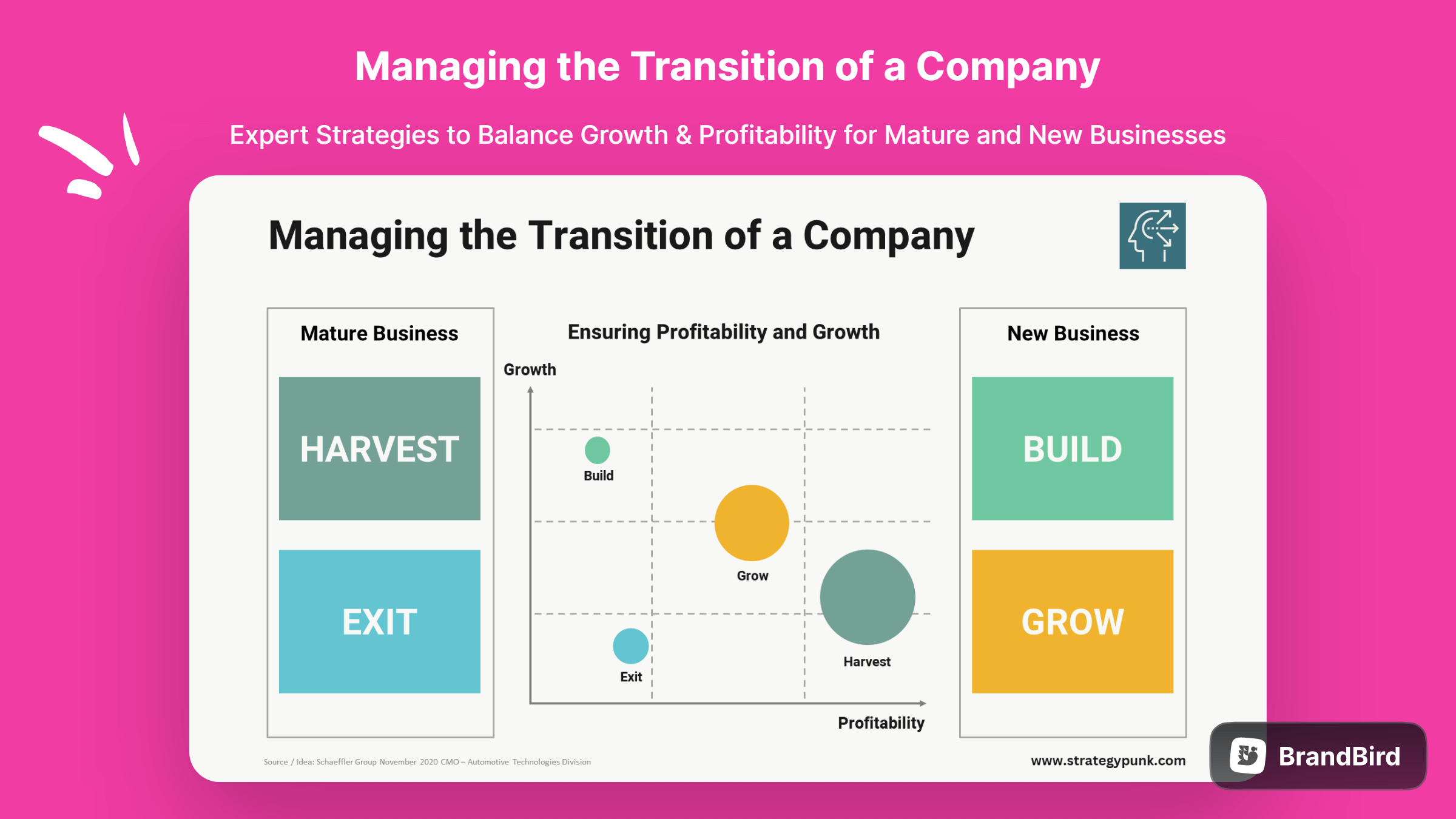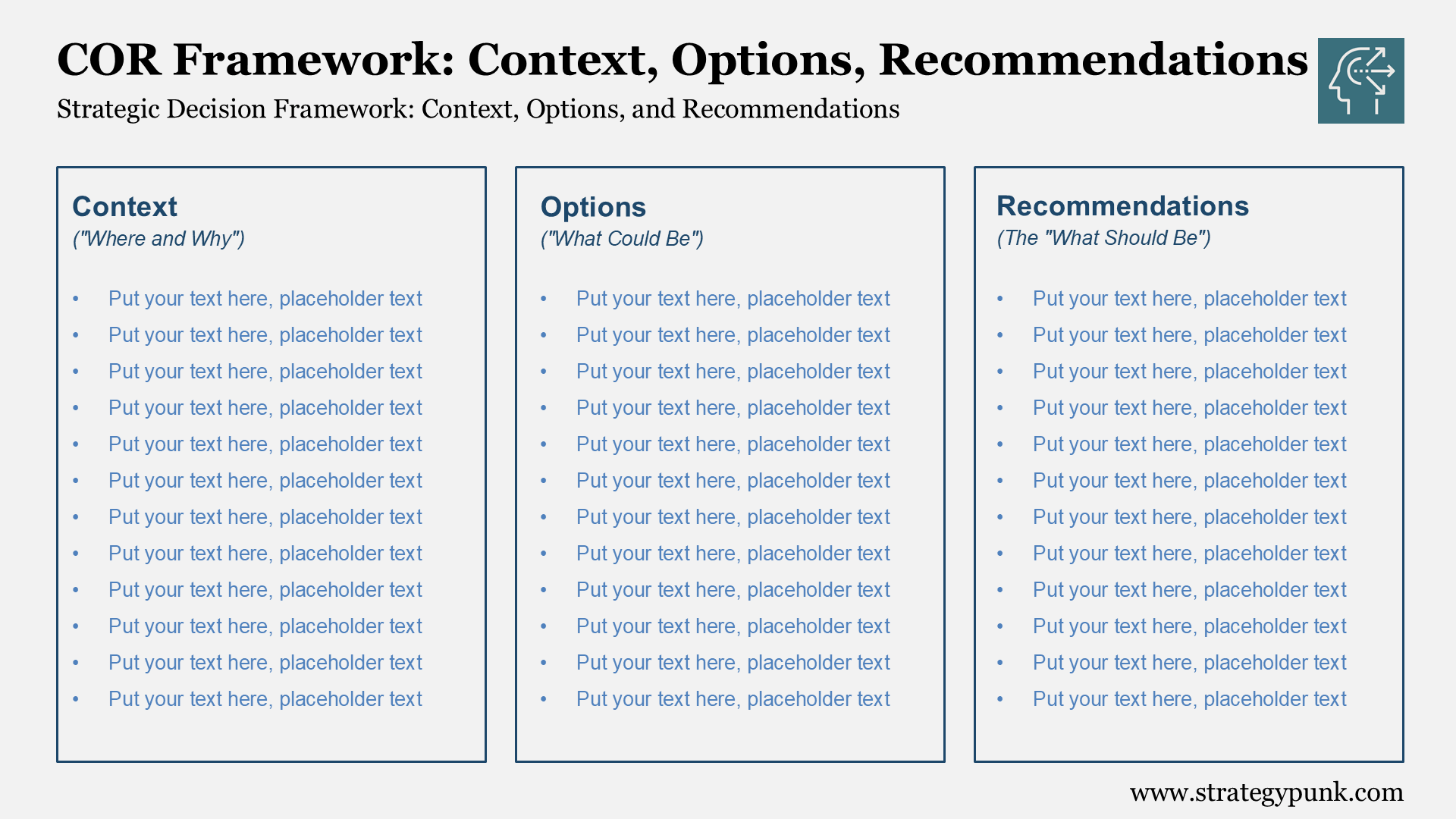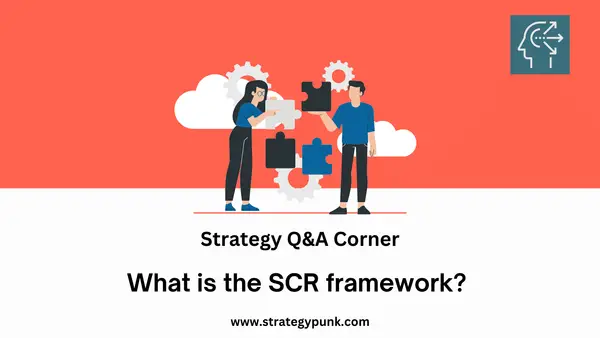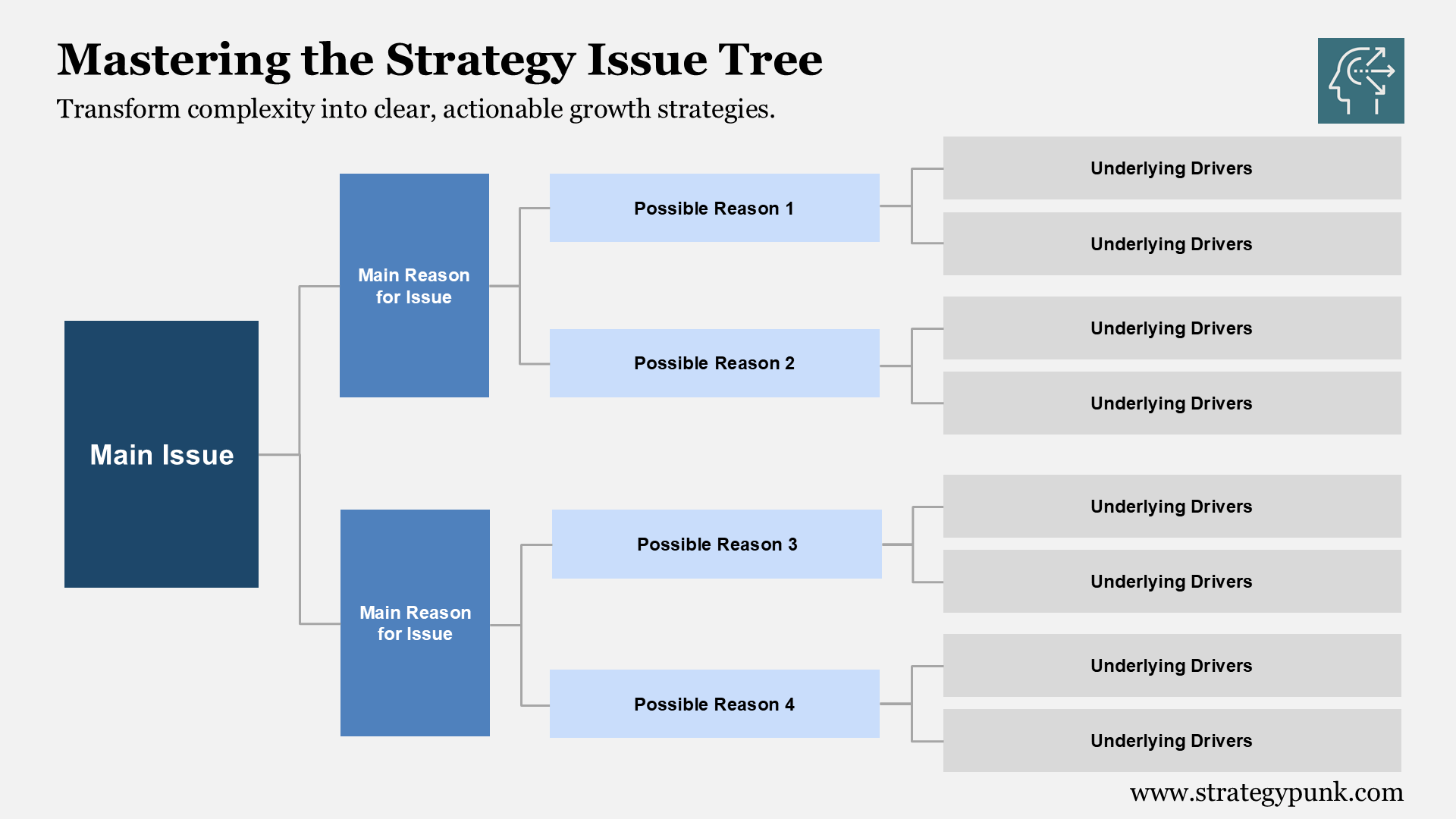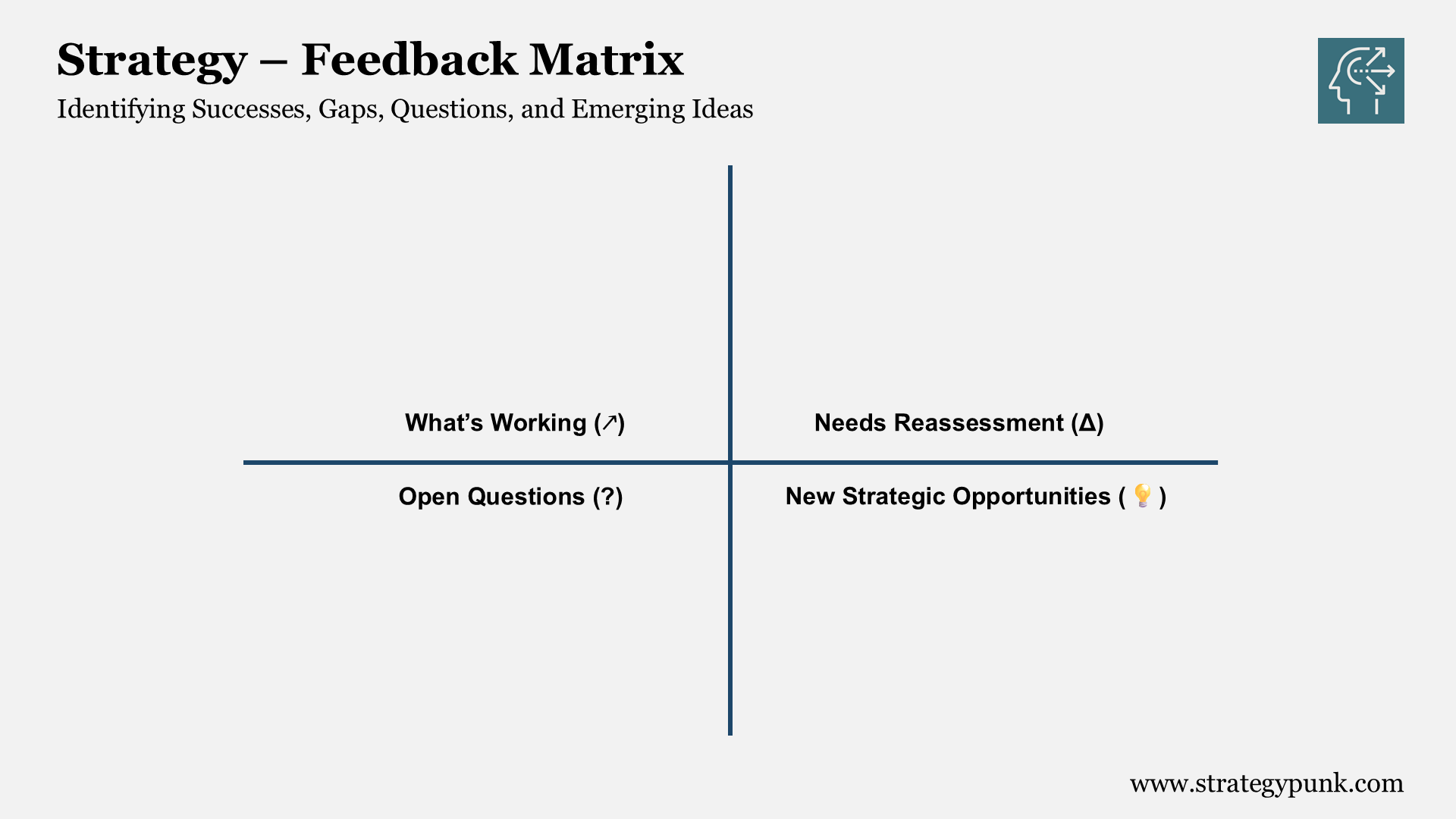The Business Lifecycle Matrix: A Guide to Harvest, Build, Grow, and Exit Your Business
Discover the Business Lifecycle Matrix: Four key phases - Harvest, Build, Grow, Exit - guiding businesses from inception to a successful transition. By understanding each phase's unique challenges and opportunities, entrepreneurs can make informed decisions to ensure successful business transitions.
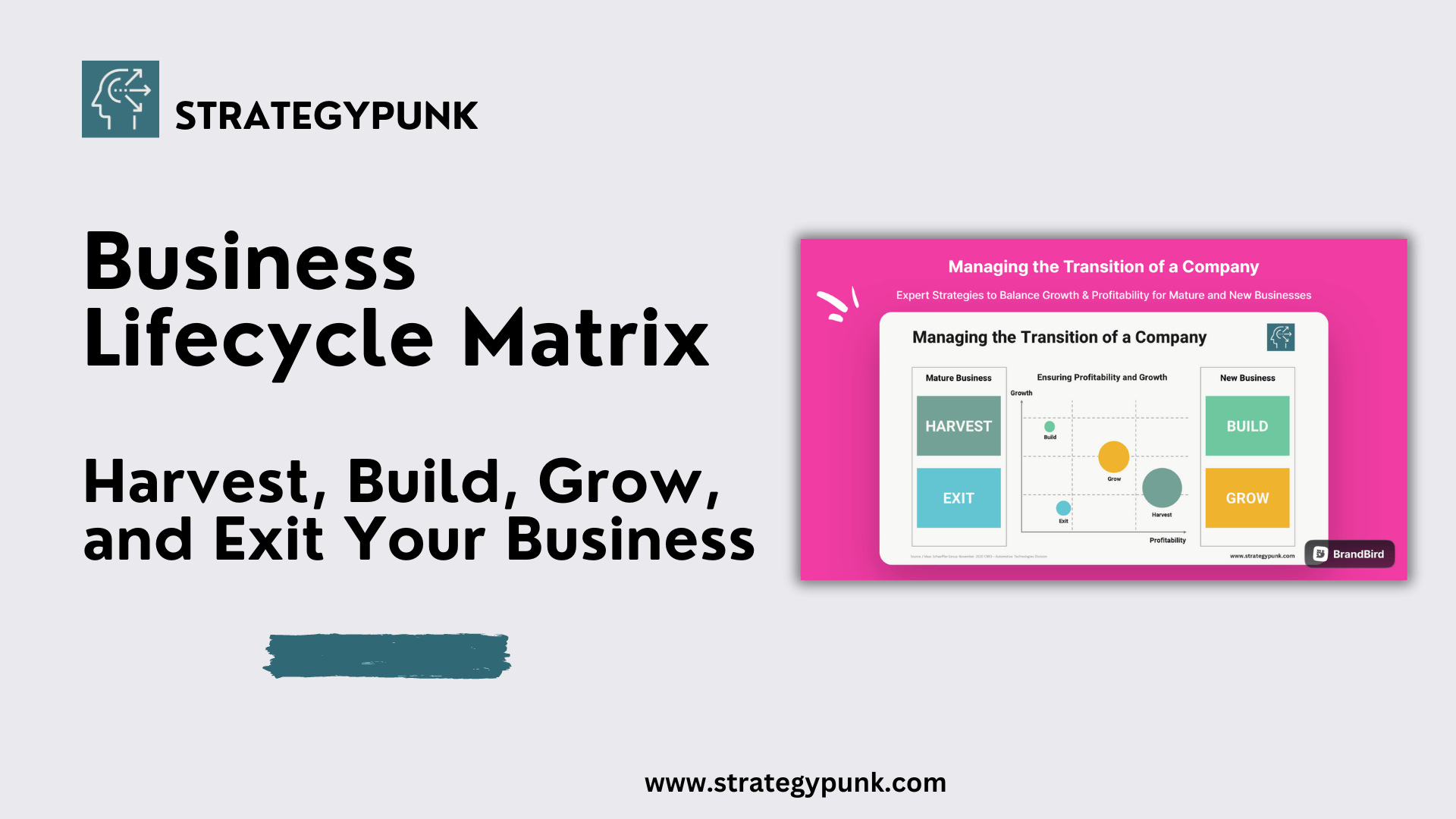
Introduction
Are you a business owner looking to understand the different phases of your business's lifecycle? The Business Lifecycle Matrix: Harvest, Build, Grow, and Exit is a framework that can help you do that. This matrix breaks down a business's lifecycle into four distinct phases, each with unique characteristics and challenges.
The first phase is the Harvest phase, which focuses on maximizing profits and minimizing costs. This is typically the final phase of a business's lifecycle when the owner wants to exit the business. The Build phase is when the company is just starting, focusing on establishing the business and building a customer base. The firm has established itself in the growth phase, focusing on expanding and growing the business. Finally, the Exit phase is when the business owner wants to sell or transfer the company to someone else.
Understanding the Business Lifecycle Matrix can help you make better decisions for your business. By identifying your business's phase, you can tailor your strategies and focus your efforts on the areas with the most impact.
Keep reading to learn more about each phase and how to implement the matrix in your business.
Understanding the Business Lifecycle Matrix
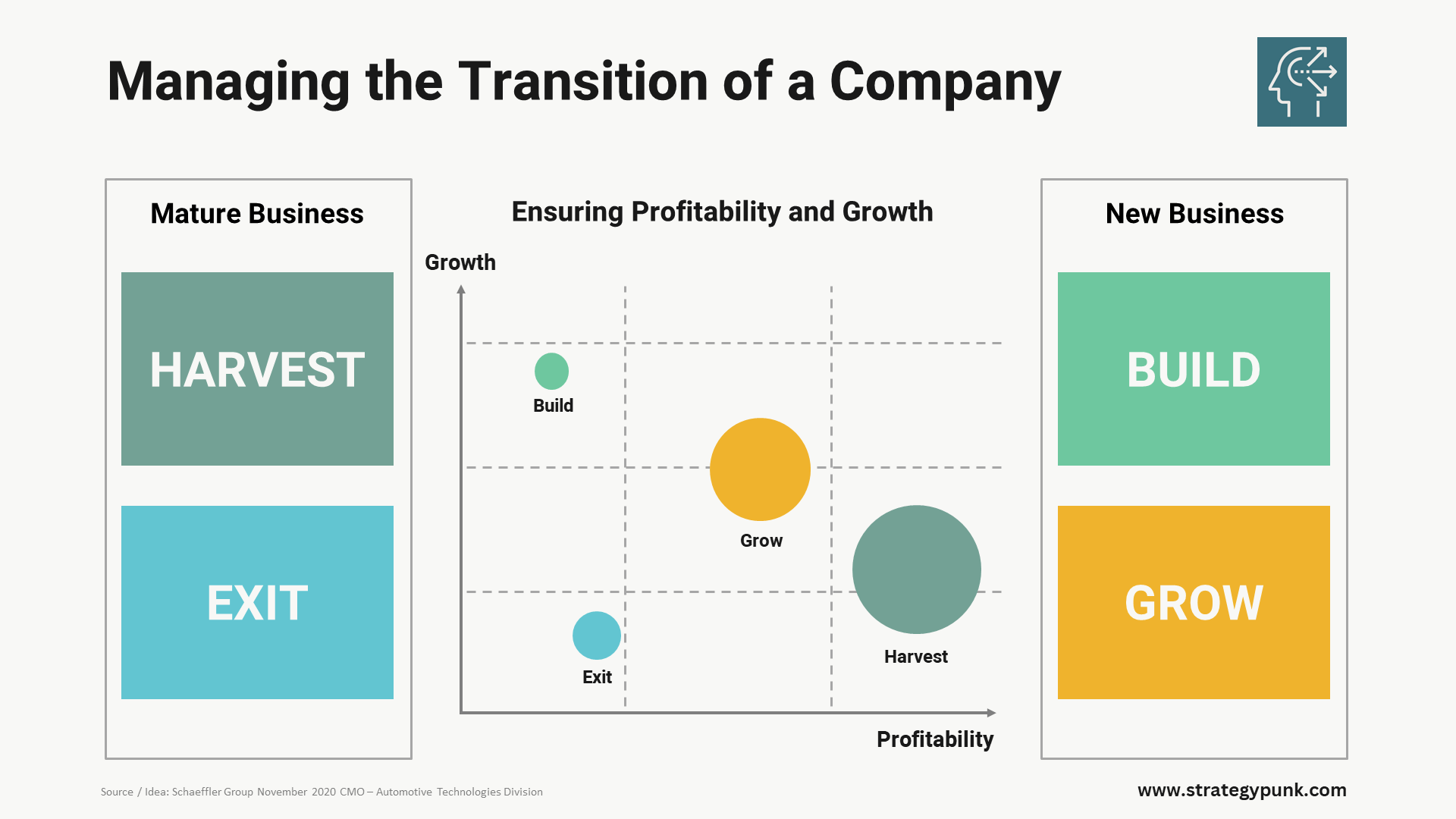
Understanding the Business Lifecycle Matrix
As an entrepreneur or business owner, it's crucial to understand the different stages of the business lifecycle to manage your company's growth and profitability effectively. The Business Lifecycle Matrix is a tool that can help you identify where your business currently stands regarding growth and development and what actions you need to take to move forward.
The Business Lifecycle Matrix consists of four stages: harvest, Build, Grow, and Exit. Each step represents a different phase of the business lifecycle and requires different strategies and tactics to succeed.
The Seed and Development stage is the first stage of the Business Lifecycle Matrix. This is the stage where you are just starting your business and focused on developing your product or service and building your customer base. At this stage, you must create a strong foundation for your business, including developing a solid business plan, building a strong team, and establishing a clear brand identity.
The Growth and Establishment phase is the next stage of the Business Lifecycle Matrix. Your business has started gaining traction at this stage, and you are focused on scaling your operations and expanding your customer base. It would be best to focus on developing a strong marketing strategy, building a robust sales team, and establishing a solid financial foundation for your business.
The Maturity phase is the third stage of the Business Lifecycle Matrix. At this stage, your business has achieved stable growth and profitability and is focused on maintaining its position in the market. Concentrating on optimizing your operations, developing new products and services, and building strong customer relationships will help.
The Decline stage is the final stage of the Business Lifecycle Matrix. Unfortunately, your business has started to decline at this stage, and you need to take action to turn things around. It would help if you focused on identifying the root causes of your business's decline, developing a plan to address these issues, and executing it effectively.
By understanding the different stages of the Business Lifecycle Matrix, you can develop a clear roadmap for your business's growth and development. Whether you are just starting or looking to take your business to the next level, the Business Lifecycle Matrix can help you achieve your goals.
Related Posts:
The Business Lifecycle Matrix: Harvest Phase
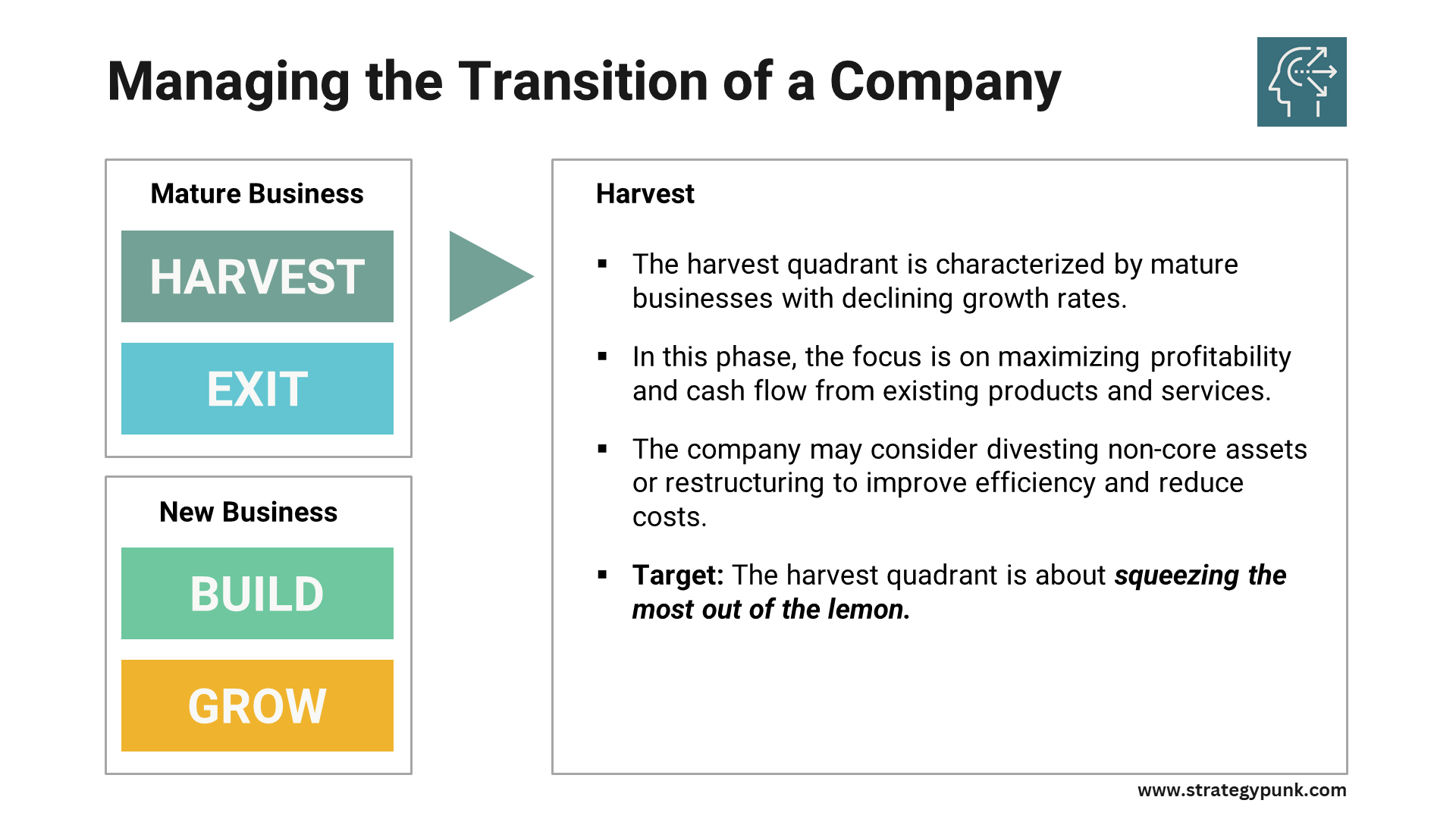
Congratulations! You have reached the Harvest Phase of the Business Lifecycle Matrix. This phase is about reaping the rewards of your hard work and maximizing profits. In this phase, you will focus on selling your business or divesting certain assets to generate cash flow.
The primary goal of the Harvest Phase is to generate profits and cash flow. You will want to maximize your revenue and cash reserves while minimizing expenses. This is the time to be efficient and ensure your business runs smoothly.
You must evaluate your assets and determine the most valuable ones to ensure you get the most out of your business. This could include selling off parts of your business, divesting certain assets, or even selling the entire company. You will want to ensure you get the best value for your purchases, so consulting with a business broker or financial advisor may be helpful.
A critical aspect of the Harvest Phase is ensuring you have a solid plan for using the cash generated from the sale of your assets. You can reinvest the money into another business venture or use it to fund your retirement. Whatever your plans, it is essential to have a clear strategy in place.
The Harvest Phase is about maximizing profits and generating cash flow. You will want to evaluate your assets, divest certain parts of your business, and make sure you have a solid plan for what to do with the cash generated from the sale of your assets. With careful planning and execution, you can make the most out of this phase and set yourself up for a successful future.
The Business Lifecycle Matrix: Build Phase
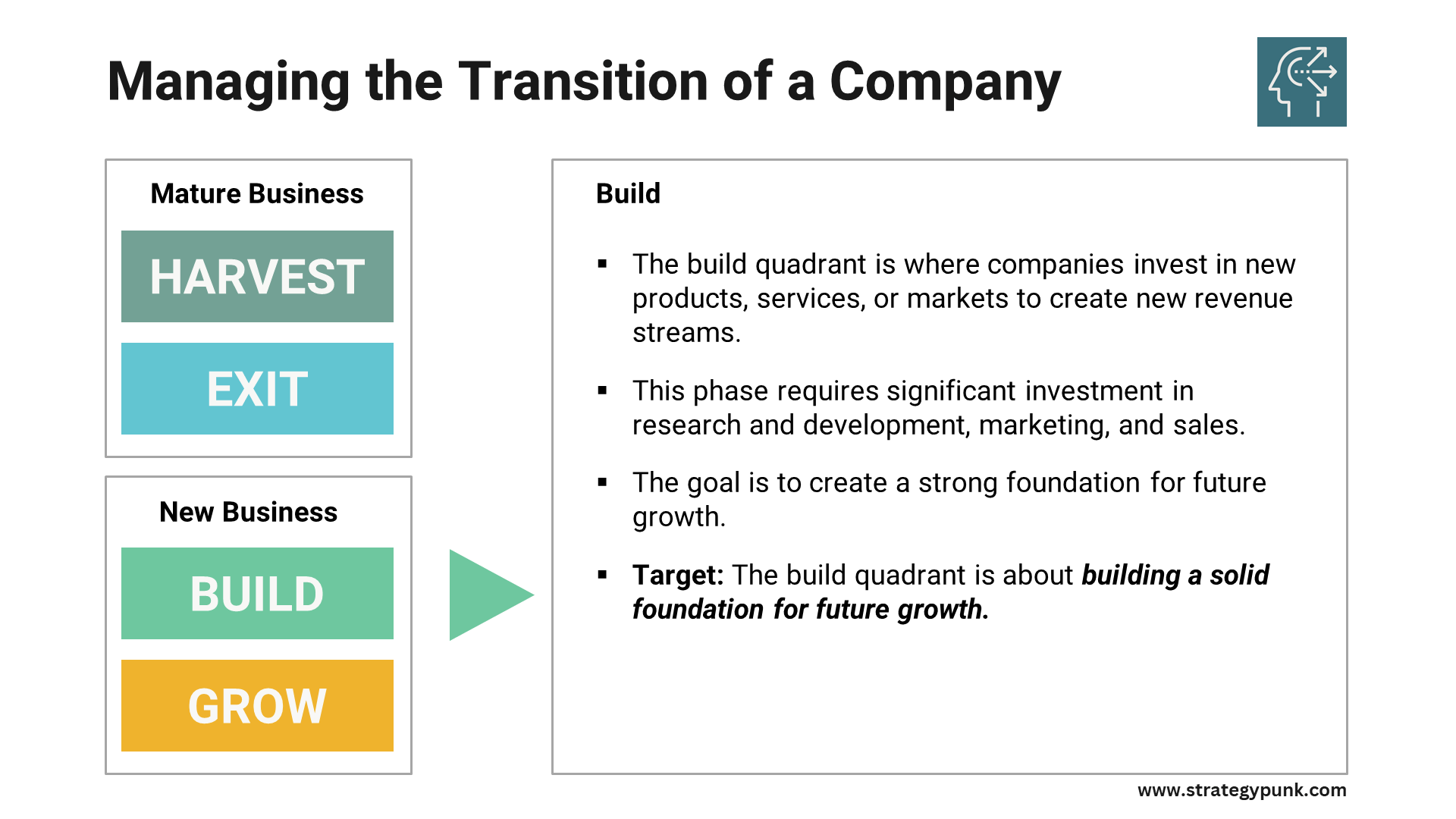
Congratulations! You have successfully established your business and are now in the Business Lifecycle Matrix Build phase. This phase is all about growth and expansion. It is time to invest in your business and scale it up to reach its full potential.
During the Build phase, you must focus on developing your business model and creating strategies to help you achieve your goals. This is the time to invest in resources, such as hiring new employees or upgrading your technology, to help you grow your business.
A solid plan is essential to ensuring success during the Build phase. This plan should outline your goals, strategies, and resources needed to finish them for you. It should also include a learning component to evaluate your progress and adjust your strategy accordingly.
One of the most critical aspects of the Build phase is establishing a solid market position. You must identify your target market and develop strategies to reach them effectively. This may involve developing new products or services, expanding your marketing efforts, or establishing partnerships with other businesses.
Overall, the Build phase is an exciting time for startups and businesses. It is a time to invest in your business and watch it grow. With the right strategies, resources, and planning, you can establish a strong market position and achieve your goals.
The Business Lifecycle Matrix: Grow Phase
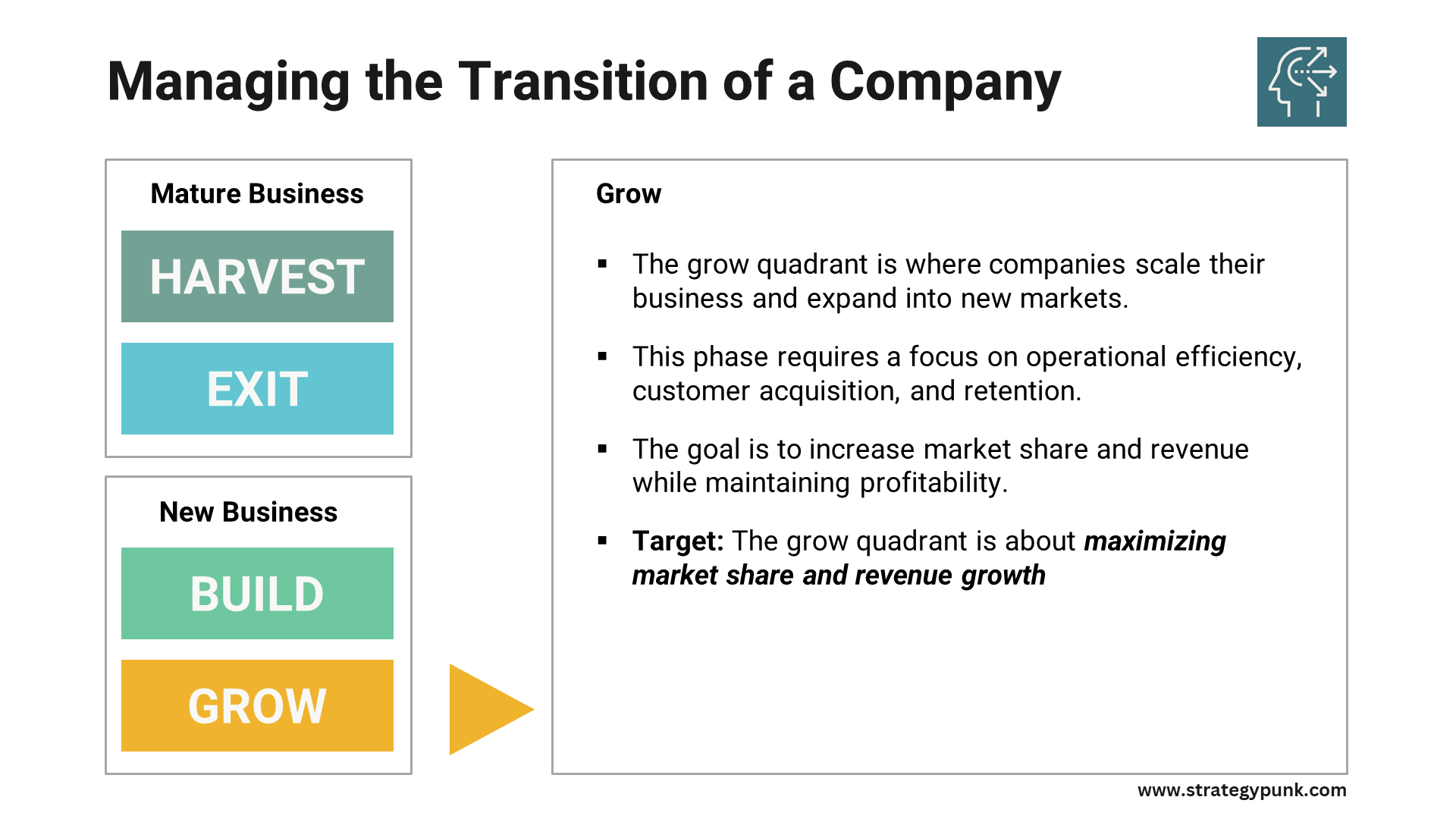
Congratulations! You've successfully navigated through the Harvest Phase of the Business Lifecycle Matrix, and now it's time to move on to the Grow Phase. In this phase, you'll focus on expanding and accelerating your business's growth.
One of the primary goals of the Grow Phase is to increase your market share. This can be achieved by increasing your sales and customer base. Focus on acquiring new customers while retaining existing ones. Doing so will build a loyal customer base supporting your business for years.
To achieve rapid growth, you'll need to expand your product offerings. This can be done by introducing new products or services that complement your existing offerings. Before launching your latest products, it's essential to conduct market research to ensure that there is demand for them.
As your business grows, you must expand your team to meet the increased demand. Hiring new employees can be daunting, but finding the right people who share your vision and values is crucial.
Keeping a close eye on your finances is essential in the growth phase. Rapid growth can be expensive, and you'll need to ensure you have the necessary resources to sustain it. This may require seeking additional funding from investors or taking out loans.
Overall, the Grow Phase is an exciting time for your business. By focusing on expanding your customer base, introducing new products, and building a solid team, you'll be well on your way to achieving long-term success.
The Business Lifecycle Matrix: Exit Phase
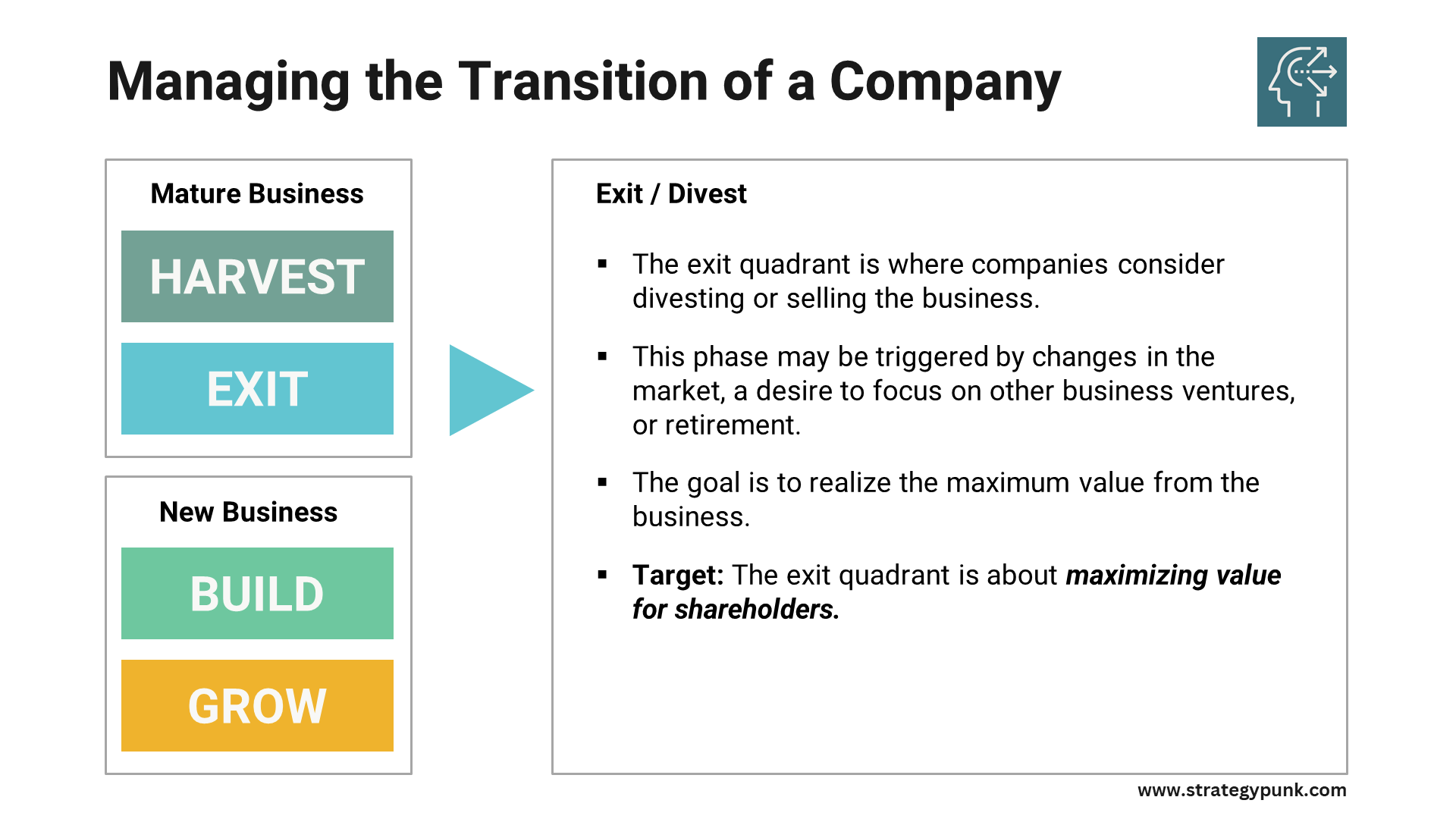
Congratulations. You have reached the final phase of the Business Lifecycle Matrix—exit. This is the phase where you will exit your business and reap the rewards of your hard work. However, this phase can be challenging and requires careful planning.
One of the first things you need to consider is your exit strategy. Several exit strategies include selling your business, merging with another company, or shutting down your business. Each strategy has pros and cons, so weighing your options carefully is essential.
If you decide to sell your business, you must find a buyer willing to pay a fair price. This can be a lengthy process, so patience is essential. It would be best to consider hiring a broker to help you find a buyer and negotiate a deal.
If you decide to merge with another company, you must find a company that is a good fit for your business. This can be a great way to expand your business and increase your profits, but it can also be a complex process. You will need to negotiate the merger terms and ensure that both companies are a good fit for each other.
If you decide to shut down your business, you must tie up any loose ends and ensure all your debts are paid off. This can be a complex and emotional process, but it's essential to do it properly to avoid legal issues.
No matter which exit strategy you choose, a plan is essential. This will help you stay on track and exit your business smoothly and efficiently.
As you move through the Exit phase, your business may also decline. This is a normal part of the process, but managing this decline carefully ensures you can exit your business on a high note.
The Exit phase can be challenging but rewarding for any business owner. With careful planning and a solid exit strategy, you can confidently exit your business and move on to your next adventure.
The Business Lifecycle Matrix: Implementation and Challenges
Now that you understand the Business Lifecycle Matrix and its four stages, it's time to dive into the implementation process. Implementing the matrix can be challenging, but it is essential for the long-term success of your business.
First and foremost, effective management is crucial when implementing the matrix. You need to have a clear understanding of the product life cycle and be able to identify which stage your products are in. This will help you determine the appropriate strategy for each product. Additionally, you need to be able to make tough decisions about harvesting or divesting products that are no longer profitable.
Another challenge you may face when implementing the matrix is fierce competition. As you enter the growth stage of the product life cycle, you will likely face increased competition. It would be best to continually improve your products and marketing strategies to stay ahead of the competition.
Marketing, advertising, and brand awareness are crucial during the growth stage. You must ensure your target audience knows about your products and what differentiates them from the competition. This is also an excellent time to establish your brand identity and build a loyal customer base.
One of the biggest challenges you may face when implementing the matrix is the need to be agile and adaptable. The business environment is constantly changing, and you need to be able to enter and exit markets whenever necessary. This requires a willingness to take risks and pivot your strategy when needed.
In conclusion, implementing the Business Lifecycle Matrix can be a challenging process, but it is essential for the long-term success of your business. Effective management, staying ahead of the competition, marketing, brand awareness, and adaptability are crucial components of successful implementation.
The Business Lifecycle Matrix: The Role of Funding and Capital
As you navigate the Business Lifecycle Matrix, funding and capital are the most important factors to consider. This is especially true during the Build and Grow stages, where you must invest in your business to take it to the next level.
There are several ways to obtain funding and capital for your business. One option is to use your savings or take out a loan. However, if you need more funding, consider seeking outside investors.
Equity financing is a popular option for many businesses. This involves selling a portion of your business to investors in exchange for funding. This can be a great way to obtain the capital you need to grow your business without debt.
Another option is venture capital. This involves seeking out investors willing to invest in your business in exchange for a share of ownership. Venture capitalists often invest in high-growth companies with the potential for significant returns.
It's important to note that seeking outside funding and capital often involves giving up some control over your business. You must work closely with your investors to ensure your business meets their expectations and goals.
Funding and capital play a crucial role in the Business Lifecycle Matrix. By securing the financing you need to grow and expand your business, you'll be better equipped to navigate the challenges and opportunities that come your way.
Future of Business Lifecycle Matrix
The Business Lifecycle Matrix has been a popular tool for businesses to identify the stage of their products and make strategic decisions accordingly. However, with the rapid evolution of technology and changing market trends, the future of the Business Lifecycle Matrix is up for debate.
One potential future for the Business Lifecycle Matrix is increased flexibility. As businesses become more agile and adaptable, the traditional linear progression through the matrix may no longer be relevant. Instead, companies may need to be able to move back and forth between stages as required.
Another potential future for the Business Lifecycle Matrix is a shift away from routine. With the rise of automation and artificial intelligence, routine tasks may become increasingly automated, allowing businesses to focus on more strategic decision-making. This may require a new approach to the Business Lifecycle Matrix that considers the changing role of routine tasks.
Technology will likely play a more significant role in the Business Lifecycle Matrix. As businesses become more reliant on technology, the matrix may need to be updated to reflect its impact on each stage of the product lifecycle. This could include new product development and testing stages and increased emphasis on data-driven decision-making.
Overall, the future of the Business Lifecycle Matrix is likely shaped by a combination of technological advancements and changing market trends. As businesses adapt, the matrix must evolve to remain relevant and valuable. By staying flexible and open to new approaches, companies can continue to use the matrix to make strategic decisions and achieve long-term success.
Business Lifecycle Matrix Frequently Asked Questions
What are some examples of harvesting strategies in business?
Harvesting strategies in business refer to ways of extracting value from a business, such as selling assets, reducing investments, or liquidating the business. One example of a harvesting strategy is focusing on short-term profits by cutting costs and reducing investments in long-term growth. Another example is selling off parts of the business that are no longer profitable or do not fit the company's long-term strategy.
What is the build, hold, harvest, and divest strategy?
The build, hold, harvest, and divest strategy is a framework for managing a business's portfolio of products or services. The strategy involves:
- Building new products or services.
- Holding onto them as they mature and grow.
- Harvesting them for short-term profit when they reach maturity.
- Eventually, divesting them when they are no longer profitable or strategic.
What are some methods of harvesting a business?
Some business harvesting methods include selling off assets, reducing investments, cutting costs, and liquidating the business. Other methods include:
- Spinning off parts of the business as separate entities.
- Merging with other companies.
- Going public through an initial public offering (IPO).
What does it mean to exit a business, and how does it fit into the business lifecycle?
Exiting a business refers to selling or liquidating it. It is a critical step in the business lifecycle, as it allows business owners to realize the value of their investment and move on to new opportunities. Exiting a business can be a voluntary decision, such as when the owner decides to retire or pursue other interests, or it can be forced, such as when the business is no longer profitable or sustainable.
What is the BCG Matrix, and how does it relate to the Business Lifecycle Matrix?
The BCG Matrix is a strategic planning tool that helps companies analyze their business units, product lines, or brands. It is used to determine which products or services are generating the most revenue and which ones are not. The matrix is divided into four quadrants: stars, cash cows, dogs, and question marks. The Business Lifecycle Matrix is a similar framework that helps companies understand where their products or services are in their lifecycle, from introduction to decline. The BCG Matrix can be used with the Business Lifecycle Matrix to help companies decide which products or services to invest in, harvest, or divest.
Related Posts:
Business Lifecycle Matrix Key Takeaways
- The Business Lifecycle Matrix breaks down the lifecycle of a business into four distinct phases: Harvest, Build, Grow, and Exit.
- Understanding which phase your business is in can help you make better decisions and tailor your strategies.
- Each phase has its unique characteristics and challenges, and the matrix can be implemented to help you navigate them.
Business Lifecycle Matrix: FREE PowerPoint Template
